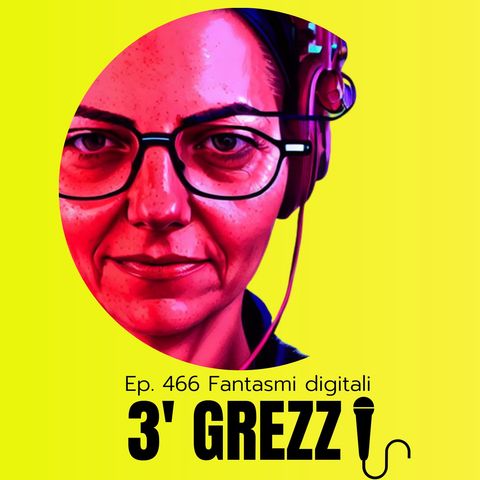3' grezzi Ep. 466 Fantasmi digitali

Sign up for free
Listen to this episode and many more. Enjoy the best podcasts on Spreaker!
Download and listen anywhere
Download your favorite episodes and enjoy them, wherever you are! Sign up or log in now to access offline listening.
3' grezzi Ep. 466 Fantasmi digitali
Description
Vecchie videocassette, musicassette con l'etichetta scritta a mano ritrovate nel fondo di un armadio, telefisioni dalle dimensioni mostruose che trasmettono l'effetto neve, spezzoni di cose viste decenni fa che continuano...
show moreTRASCRIZIONE [ENG translation below]
Uhhhhh! Paura, eh? Oggi parlo di fantasmi, anzi di un tipo particolare di fantasmi, quelli che popolano il genere conosciuto come folclore digitale, il digital folklor, che ha questa caratteristica particolare, che nel nome ha la parola digitale, però è ambientato in luoghi che digitali non lo sono affatto, infatti il folclore digitale è caratterizzato da oggetti come vecchie videocassette ritrovate in soffitta, musicassette, grandi apparecchi televisivi dove non ci sono trasmissioni ma le televisioni sono accese e c'è quello che si chiama effetto neve, sapete, quando non si vede niente fa ccchhhhh, che mi chiedo se questo sia possibile con le nuove televisioni, non l'ho mai visto.
Comunque, ho trovato un'interessante riflessione sul perché il folclore digitale sia basato su questi vecchi strumenti e non su strumenti più moderni.
Quando io ero bambina, se mi capitava di vedere una cosa inquietante alla televisione, e vi assicuro che alla tv dei ragazzi cose inquietanti se ne vedevano tantissime, anche perché negli anni '70 si era in piena sperimentazione artistica, quindi c'erano persone, artisti importanti che facevano i programmi per i bambini e questi programmi però si potevano vedere solo alla televisione.
E quando si vedeva qualcosa di strano, di inquietante, qualcosa che accendeva la nostra fantasia, non si poteva correre su YouTube a riguardarlo, esaminarlo o a elaborarlo. E non si poteva neanche correre su Wikipedia o su altri siti su internet perché qualcuno spiegasse cosa c'era dietro quelle invenzioni artistiche.
Quindi si vedevano cose inquietanti alla televisione che poi rimanevano dentro di noi, e tutti gli spazi, le lacune di cose che da bambini, da ragazzi ma anche da adulti, non si riusciva a spiegare, venivano riempite con le nostre fantasie, le nostre paure più recondite e quindi diventavano il nostro incubo ideale diciamo cucito su misura.
E il folclore digitale riprende proprio questo tipo di atteggiamento, questo tipo di inquietudine, e fa vedere cose che ci sono e non ci sono, si capiscono e non si capiscono, cose anche un po' difficili da spiegare concettualmente.
È una cosa affascinante questa nuova interpretazione del folclore digitale che ho avuto modo di leggere e di ascoltare nel fine settimana, mi ha incuriosito.
Voglio scavare a fondo e mi sono tornati in mente anche alcuni programmi di quando ero bambina che erano abbastanza terrificanti.
TRANSLATION
Uhhhh! Afraid, eh? Today I am talking about ghosts, or rather a particular kind of ghosts, those that populate the genre known as folclore digitale, digital folklor, which has this particular characteristic, that is, it has the word digital in its name, however it is set in places that are not digital at all, in fact digital folklore is characterized by objects like old videotapes found in the attic, cassette tapes, large television sets where there are no broadcasts but the televisions are on and there is what is called the snow effect, you know, when you can't see anything it goes sshhhh, which I wonder if this is even possible with the new televisions, I've never seen it.
Anyway, I found an interesting reflection on why digital folklore is based on these old tools and not on more modern tools.
When I was a child, if I happened to see a disturbing thing on television, and I can assure you that on children's TV, disturbing things were seen a lot, also because in the 1970s we were in the midst of artistic experimentation, so there were people, important artists who were making programs for children, and these programs, however, could only be seen on TV.
And when you saw something strange, something disturbing, something that ignited your imagination, you couldn't run to YouTube and watch it again, examine it or process it. Nor could you run to Wikipedia or other sites on the Internet for someone to explain what was behind those artistic inventions.
So we used to see disturbing things on television that then stayed within us, and all the spaces, the gaps of things that as children, as teenagers but also as adults, we could not explain, were filled with our fantasies, our innermost fears and thus became our ideal nightmare, let's say tailor-made.
And digital folklore picks up just this kind of attitude, this kind of restlessness, and it shows things that are there and are not there, you understand and you don't understand, things that are also a little bit difficult to explain conceptually.
It's a fascinating thing, this new interpretation of digital folklore that I read and listened to over the weekend, it intrigued me.
I want to dig deep, and I was also reminded of some programs from when I was a child that were quite terrifying.
Information
| Author | M. Cristina Marras |
| Organization | M. Cristina Marras |
| Website | - |
| Tags |
Copyright 2024 - Spreaker Inc. an iHeartMedia Company
